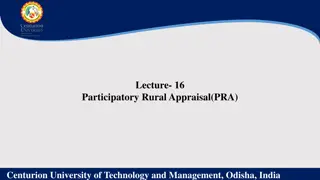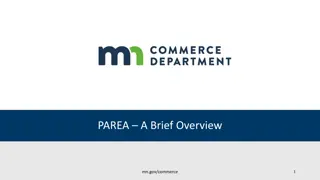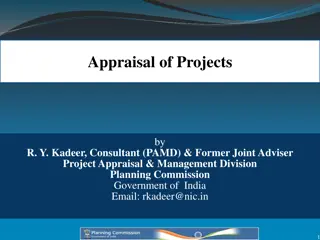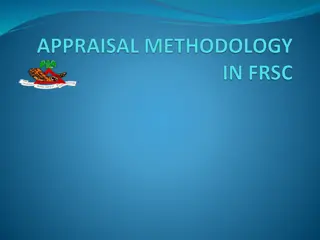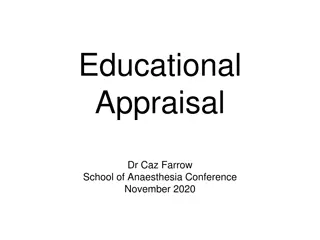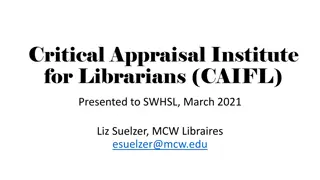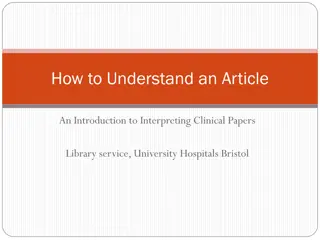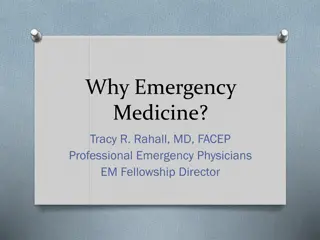Understanding Critical Appraisal in Medicine
Dive into the world of critical appraisal in medicine, covering topics such as format, statistics, types of data, p-values, confidence intervals, randomisation, blinding, and more. Learn how to dissect research papers, interpret results, and apply findings to clinical practice effectively.
Download Presentation

Please find below an Image/Link to download the presentation.
The content on the website is provided AS IS for your information and personal use only. It may not be sold, licensed, or shared on other websites without obtaining consent from the author. Download presentation by click this link. If you encounter any issues during the download, it is possible that the publisher has removed the file from their server.
E N D
Presentation Transcript
Format 90 minutes Diagnostic or therapeutic papers SAQ Summary / abstract Design good / bad points Definitions What do the results mean? How do the results relate to practice? Implement or not?
Types of Data Continuous Normal distribution parametric tests such as t test, ANOVA mean Non-normal distribution non-parametric tests such as Mann Whitney U, Wilcoxon rank sum, Kruskall Wallis median Categorical Nominal chi squared test Fisher s exact test mode Ordinal
P Value Probability that the result (difference) you see has arisen purely by chance if null hypothesis true Arbitrary level of 0.05 (1 in 20) set as level of statistical significance This is not the same as clinical significance!
If the coin comes down heads, does that mean it is loaded? What if the coin had more metal on the tail side?
Confidence Interval Usually quoted as 95% We can be 95% sure / confident / certain that the actual value lies within the range quoted (There is a 5% chance that the actual value lies outside of this range of values) NOT that 95% of the values lie within the range
Randomisation Subjects are randomly assigned to a particular (treatment) group Random number generator Sealed envelopes Batch randomisation Cluster randomisation Tries to ensure each group is similar (table 1 demographics) apart from the treatment Some studies do not need randomisation! Diagnostic studies are cohorts where every subject should have test and gold standard
Blinding Hawthorne, Rosenthal / Pygmalion, John Henry effects, self fulfilling prophecy Allow for human behaviours that might affect subjective measures / outcomes Not all studies need to be blinded! Objective measures
Blinding Similar medication appearances Sham surgery Data collectors unaware of treatment group Gold standard unaware of results of test
Inter-Observer Agreement Do you get similar results with the same test when read by different people? Kappa value -1 (complete disagreement) to +1 (complete agreement) 0 = agreement purely by chance
Power The ability of a study to find a difference should a difference exist Determined by: Size of difference Level of accepted statistical significance (alpha usually standard 0.05) Desired chance / ability to detect the difference (beta usually set at 80%) Sample size Sample size required is N for an 80% power to detect a difference of x at the p=0.05 level
Intention to Treat Preserves effects of randomisation Mirrors real world activity withdrawals, incomplete treatments, using additional treatments
Test Characteristics Sensitivity Specificity Predictive values Likelihood ratios ROC curve
2 x 2 Table Gold standard Disease Disease Present Absent a (TP) b (FP) Test score: Test positive Test negative c (FN) d (TN) Sensitivity Specificity = a/(a+c) = d/(b+d) Note SpIn vs SnOut
What Do the Sensitivity and Specificity Not tell You? Sensitivity & specificity derived from comparison with gold standard Implies you already know the diagnosis Doesn t tell you what a particular test result means for your patient So does my patient have disease or is the result a false positive? 19
Most Tests Provide a Continuous Score. Selecting a Cutting Point Test scores for a healthy population Sick population Healthy scores Pathological scores Possible cut-point Move this way to increase sensitivity (include more of sick group) Crucial issue: changing cut-point can improve sensitivity or specificity, but never both Move this way to increase specificity (exclude healthy people)
2 x 2 Table for Testing a Test Gold standard Disease Disease Present Absent a (TP) b (FP) Test score: Test +ve Test -ve PPV = a/(a+b) NPV = d/(c+d) c (FN) d (TN) Sensitivity Specificity = a/(a+c) = d/(b+d) 21
Positive and Negative Predictive Values Given a test result, what is the probability the patient has / doesn t have disease? But very dependent on prevalence As prevalence goes down, PPV goes down (it s harder to find the smaller number of cases) and NPV rises. May not be applicable to your population if local prevalence is different
Prevalence and Predictive Values B. Primary care A. Specialist referral hospital D + D - D + D - 50 100 50 10 T + T + T - T - 5 1000 5 100 Sensitivity = 50/55 = 91% Specificity = 100/110 = 91% Sensitivity = 50/55 = 91% Specificity = 1000/1100 = 91% Prevalence = 55/165 = 33% Prevalence = 55/1155 = 3% PPV = 50/60 = 83% NPV = 100/105 = 95% PPV = 50/150 = 33% NPV = 1000/1005 = 99.5% 23
Likelihood Ratios Odds of a given test result in a patient with the disease as opposed to a patient without Advantages: Combines sensitivity and specificity into one number Can be calculated for many levels of the test Not dependent on prevalence Can calculate probabilities of disease (Bayesian theory) LR for positive test = Sensitivity / (1-Specificity) LR for negative test = (1-Sensitivity) / Specificity Relationship to ROC curve
Stats Summary Types of data P value Confidence intervals Randomisation Blinding Interobserver agreement Power Intention to treat Test characteristics Sensitivity / specificity Predictive values Likelihood ratios ROC curves
Format 90 minutes Diagnostic or therapeutic papers SAQ Summary / abstract Design good / bad points Definitions What do the results mean? How do the results relate to practice? Implement or not?
Summary / Abstract Aim / objective What was the main point they were looking at? Methods Who, where, when, how Randomised? Blinded? (if relevant) Results Main points think about the aim. Don t get caught up with cramming in all of the secondary analyses Conclusion Authors not yours! Link back to aim 200 word limit, use bullet points
Design What are the good things about the design? Are there any aspects that mean the patients may not be entirely the type of patients you see? Highly selected lots of exclusions? Restricted inclusion criteria? Randomisation / blinding where appropriate were these done well? Did they use the correct statistical tests? Look at the limitations (usually separate section or at beginning of Discussion)
Definitions Types of data P value Confidence intervals Randomisation Blinding Interobserver agreement Power Intention to treat Test characteristics Sensitivity / specificity Predictive values Likelihood ratios
Results Was there a difference? If so, can the findings be put into clinical practice? What is the size of difference? How does it relate to current or future practice?
Relevance to Clinical Practice Would you implement the findings in the study? Look at the limitations of the study Do these limitations mean the results can t be generalised to the population we treat?
Tips Read the questions before reading the paper Don t worry too much about the numbers / stats, this is a comprehension exercise KISS: don t use technical jargon (unless you really know what it means, REALLY) Answer the question: correct but irrelevant statements don t score Look at the size of the answer box and the marks awarded to guide how much to write
Example Papers Prospective Validation of the Pediatric Appendicitis Score in a Canadian Pediatric Emergency Department Maala Bhatt, MD, MSc, Lawrence Joseph, PhD, Francine M. Ducharme, MD, MSc, Geoffrey Dougherty, MD, MSc, and David McGillivray, MD ACADEMIC EMERGENCY MEDICINE 2009; 16:591 596
Q1 Provide a no more than 200 word summary of this paper in the box provided. Only the first 200 words will be considered short bullet points are acceptable. Maximum of 7 marks available.
Q1 Many candidates did not appear to read the title ie validation , and therefore to use it in the summary Many candidates did not use all 200 words Candidates spent time counting their words this is not useful, at standard size writing the 200 words will fit on one side of paper Candidates did not state obvious aspects ie prospective diagnostic observational study Candidates commonly did not appear to realise it was a diagnostic study and many tried to apply a therapeutic appraisal framework including outcomes and intention to treat Candidates did not appear to realise that any validation of a diagnostic test will need a gold or reference standard and most commonly referred to this as an primary outcome . simply mentioning the word standard or reference would have gained marks
Q1 A summary needs to summarise so that the summary stands alone candidates failed to say what the cut off was just referring to another paper (Samuel) so that the summary did not stand alone There is no need, in the summary of the paper, to summarise the background to the paper There needs to be, in the summary, actual results numbers with some headline statistics Don t have to put headings into the summary but if you do don t put results into the conclusion Use the conclusions the authors use they will have stated them somewhere this is an easy mark to pick up don t make up your own conclusions The summary should not include your opinion of the paper the authors will not have written their own critique in the abstract! The easiest way to get marks is to learn the headings for the appraisal of a diagnostic and therapeutic paper then write them down first in the exam and fill in the blanks
Q2 The primary objective of this study was to determine the diagnostic properties of the pediatric appendicitis score cut-point of 6 for diagnosing appendicitis List four strengths of the study DESIGN in this paper
Q2 Candidates did not list strengths of the design but of the paper in general Many candidates wrote a series of buzz words but in no relevant order or failed to explain what they meant. eg pragmatic so generalisable does not demonstrate understanding of the fact that the study was done with normal staff, using normal processes and nothing unusual required In a study such as this, it is a given that there will be ethics and consent as well as data analysis such as a ROC curve. Don t state routine aspects as strengths Many candidates wrote correct statements but they were not relevant to the answers Some candidates did not pay attention to detail some stated that measuring inter-observer reliability does not decrease the error this is incorrect, it just describes /quantifies it.
Q2 Candidates put results in as strengths of design ie no loss to follow up. A more suitable answer would be it was designed that all patients who were not operated on would have a telephone follow up to ensure no missed diagnoses Candidates simply stated the stats used (sensitivity and specificity) rather than indicating how the authors set out to analyse the data in a particular way (ie designed the study) so that they could identify the reliability of the score in diagnosing appendicitis. Explanation of why elements of the design including choice of stats enhances the study is needed for this question The fact that the issue being investigated by the study is clinically relevant is not a strength of the design of the study
Q3 The paper does not mention whether those ascertaining the outcome diagnosis ( appendicitis or no appendicitis ) were blinded to the Pediatric Appendicitis Score. (a) Explain why a lack of such blinding may introduce possible bias into the results. (2 marks)
Q3 Blinding is an essential part of all research and you must be able to discuss who might be blinded (all assessors, reviewers and those doing follow up) You should also be able to articulate the impact of lack of blinding both in a subjective assessment and where the measurement is more objective eg automated outcome, alive/dead Some candidates believed that pathology reports could not be influenced by prior case knowledge and/or the knowledge of the PAS components.
Q3 Candidates often failed to recognise that bias may work in both directions. It was common to read answers suggesting that bias could only over-diagnose appendicitis Candidates failed to recognise all components of the gold standard in this study There were specific types of bias appropriate to this paper that candidates should be aware of, ie selection, sampling or attrition bias
Q4 (a) The results section of the paper reports that a Pediatric Appendicitis Score cut-point of 6 or more had a sensitivity of 92.8% and a specificity of 69.3% for the diagnosis of appendicitis. Comment on the utility of this cut point in ruling out appendicitis. (2 marks) (b) With reference to the discussion section of the paper, what is the probability that a child with a Pediatric Appendicitis Score of 8 or more does not have appendicitis? (2 marks)
Q5 Figure 2 in the paper presents a Receiver operating characteristic (ROC) curve. (a) List 2 ways by which ROC curves add to the understanding of diagnostic tests. (2 marks)
Q6 Table 2 of the paper reports that 45% of those with appendicitis and 37% with no appendicitis had imaging investigations. The difference (95% CI) is 12% (-1 to 24). (a)Is this a statistically significant difference? (1 mark) (b)Explain your answer. (1 mark)
Q7 The following is a quote from the results section of the paper: Interobserver scores were obtained in 37 (14.6%) of the 246 patients. The kappa coefficient was 0.65 (95% CI = 0.48 to 0.81) (The kappa coefficient is used to express level of agreement between observers) Comment on the level of agreement between observers in terms of the point estimate (0.65) and the 95% confidence interval (0.48 to 0.81). (2 marks)
Stats Specificity and Sensitivity in ruling in and ruling out (SPIN and SNOUT). Candidates should understand the difference between sensitivity and specificity and be able to relate this to the performance of a test in clinical practice. Positive predictive value as a way of expressing probability. Candidates should understand what a PPV or NPV means for a given population and for the result from an individual patient. ROC curves Candidates should be able to articulate their understanding of ROC curves. They should be able to differentiate test performance using a ROC curve. They should be familiar with the concept of area under the curve analysis using ROC curves. Interpreting confidence intervals. Candidates should be able to give a concise explanation of the meaning and usefulness of confidence intervals. Candidates should be able to demonstrate how confidence intervals may influence their thinking about the precision of a result. Candidates should understand the principles of the Kappa statistic and its magnitude, and general features of the analysis of interobserver reliability
Q8 Give four reasons why you would not adopt this test in your Emergency Department.
Q8 Candidates stated that the test used different practice to current that is not an acceptable reason for not adopting the test Candidates stated it was too expensive there was no evidence of cost assessment so could not be stated Have to fully explain the statements made cannot just say not specific enough you have to explain why that matters This question effectively asks the candidate to list the weaknesses/limitations of the study and its validity, applicability and importance to EM in UK.



